A Scion Society of The Baker Street Irregulars

Data! Data! Data! – The Dancing Men
“‘Data! Data! Data!‘ he cried impatiently. ‘I can’t make bricks without clay.’”
– The Adventures of the Copper Beeches (COPP)

This column is composed of material (Data!) developed for a short course called Appreciating Sherlock Holmes that I teach twice a year in the Community Education Life Enrichment Program for a local community college. It is composed of “points of information” that are common to many / most / all of the 60 Canonical stories.
The information here has been researched by me or borrowed / stolen from many efforts of other Sherlockians.
This month’s story The Adventure of the Dancing Men … (How many of us read this in 8th grade English?)
A GENERAL COMMENT ON THE STORY (by Rosemary Michaud)
“Is there a sadder story in the entire Canon than this one of Hilton Cubitt and his wife Elsie? And to think that Holmes had his hand on the key to it all, but still could not prevent the tragedy from happening! Despite the disastrous outcome, this remains one of Holmes’s great cases, made perhaps the more memorable because of our thoughts of how it might have turned out so much for the better.”
CHRISTOPHER MORLEY SAID . . .
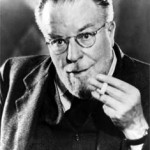 “One of the most famous of the stories, introducing the bizarre cipher on the little acrobatic figures, Holmes’s expert study of all forms of secret writing (he was the author of a monograph An Analysis of 160 Ciphers) enable him to read the threatening messages. His “knowledge of crooks of Chicago” convinced him that they meant what they said.”
“One of the most famous of the stories, introducing the bizarre cipher on the little acrobatic figures, Holmes’s expert study of all forms of secret writing (he was the author of a monograph An Analysis of 160 Ciphers) enable him to read the threatening messages. His “knowledge of crooks of Chicago” convinced him that they meant what they said.”
DUMMIES SHORT SUMMARY (From Sherlock Holmes for Dummies by Steven Doyle & David Crowder)
“This story has it all: mysterious codes, gangsters, a love triangle, murder, and one of Holmes’s greatest crime-scene investigations.”
PUBLISHING HISTORY
- This was the 30th of the 60 stories to be published
- In England in The Strand Magazine, December, 1903
- In the U.S. in Collier’s Weekly, December 5, 1903
- Part of The Return of Sherlock Holmes collection, published by George Newnes, Ltd., London, 1905 and McClure Phillip & Co., New York, 1905
- The British Illustrator was the most memorable Sidney Paget. In the U.S., Frederick Dorr Steele was the illustrator.
HOW MANY WORDS?
According to C. E. Lauderback, 1960 – – found on SHERLOCKIAN.NET website of Chris Redmond
At 9,686 words The Adventure of the Dancing Men has the 46th most words or the 56 short stories. The Naval Treaty is the longest at 12,701.
THE BEST OF SHERLOCK HOLMES (How do Sherlockians rate this story?)
- In 1927 Arthur Conan Doyle placed it 3rd on list of 12 favorites
- In 1944 the Baker Street Irregulars voted it as 5th on their top 12 favorites
- In 1954 the Baker Street Irregulars voted it as 10th on their top 12 favorites
- In 1959 the Baker Street Irregulars voted it as 9th on list of 10
- In 1999 the Sherlock Holmes Society of London voted it 10th of 56
CLASSIFYING THE CASE
This is one of only two Sherlock Holmes short stories where Holmes’ client dies after seeking his help. The other was The Five Orange Pips.
CHRONOLOGICALLY SPEAKING
Doyle was often very vague about stating WHEN the tale took place and included few contemporary references to help. Whether this was done intentionally or unthinkingly, the dating of events in the Canon is a very popular pastime pursued by several of our “scholars” researching and justifying their results to no end. We will again default to William Baring-Gould’s dating of . . . Wednesday, July 27 to Wednesday, August 10 and Saturday, August 13, 1898 make it the 44th of the 60 stories chronologically. This means that Holmes is 44 and Watson is 46.
WHAT ELSE HAPPENED IN YEAR?
It is always interesting to see what else in happening at the same time as the stories. What else was going on in 1898? (As a former history teacher, I find 1898 a most interesting year.)
- Battle of Omdurman in Sudan. Kitchner defeats Mahdi and Dervishes, avenges General Gordon’s death. (Do you know the Sherlockian connection?)
- Congo railway completed to Stanley Pools.
- Electrification of underground railway from Mansion House to Waterloo.
- First escalator at Harrod’s.
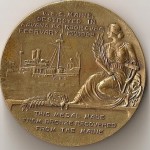 USS Maine blows up in Havana Harbor, Spanish-American War begins, Spain defeated at Santiago and Manila. Treaty of Paris ends war, Cuba becomes independent, U.S.A. acquires Philippines.
USS Maine blows up in Havana Harbor, Spanish-American War begins, Spain defeated at Santiago and Manila. Treaty of Paris ends war, Cuba becomes independent, U.S.A. acquires Philippines.- Workmen’s Social Democratic Party formed in Russia.
- “Hundred Days of Reform” in China. Deposition of Kuang-Hsu and reinstatement of Dowager Empress, suppression of reform.
- The United States annexes Hawaii.
- End of the state of being a debtor nation for the U.S.A., existing since 1783, $500 million foreign investments.
- Work begins on Aswan Dam.
- Severe food riots in Italy.
- Zola’s J’Accuse
- Wells’ War of the Worlds
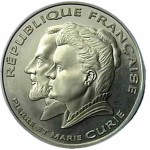
- Wilde’s Ballad of Reading Gaol is published.
- The Curies discover radium and polonium.
- Pickering, using photography, discovers nine of Saturn’s moons.
- Rudolf Diesel demonstrates his engine, which requires no sparkplugs.
- J. Owens, U.S.A., designs automatic bottle-making machine.
HOLMES AND WATSON – PERSONAL INFO
They are residing at 221B as usual.
DRAMATIS PERSONAE
- Holmes and Watson, of course.
- Hilton Cubitt of Ridingthorpe Manor, Norfolk. “A fine creature of the old English soil.” And, unfortunately, the victim.
- Elsie Cubitt, nee Patrick, his wife with a hidden past.
- Abe Slaney, killer of Hilton and childhood friend/admirer of Elsie. He’s the murderer.
- Inspector Martin, of the Norfolk constabulary. A “country” inspector grateful for Holmes’ apprehending the murderer.
“QUOTABLE SHERLOCK”
We have three quotes this month that exemplify Holmes’ views on detection.
- “You see, my dear Watson” — he propped his test-tube in the rack, and began to lecture with the air of a professor addressing his class — “it is not really difficult to construct a series of inferences, each dependent upon its predecessor and each simple in itself. If, after doing so, one simply knocks out all the central inferences and presents one’s audience with the starting-point and the conclusion, one may produce a startling, though possibly a meretricious, effect.”
- “Every problem becomes very childish when once it is explained to you.”
- “What one man can invent another can discover.”
HOLMES’ FEE
Not every story tells us what Holmes received monetarily from his clients but, since his client was killed in this one, he may have been skunked on this case.
SHERLOCK ON THE BIG SCREEN & THE LITTLE SCREEN
One of the most popular tales, but strangely, The Adventure of the Dancing Men has only 4 efforts recorded.
- 1923 – Eille Norwood in The Mystery of the Dancing Men. The National Film and Television Archive at the BFI has viewing copies of this film but it has not been released
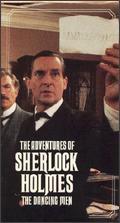 1968 – Peter Cushing played Holmes in The Dancing Men episode of the Sherlock Homes TV series. Of the 16 episodes in which Cushing stars, 11 are “lost.” This is one of them.
1968 – Peter Cushing played Holmes in The Dancing Men episode of the Sherlock Homes TV series. Of the 16 episodes in which Cushing stars, 11 are “lost.” This is one of them.- 1984 – Jeremy Brett (Holmes) and David Burke (Watson) stared in The Dancing Men for Granada‘s very first episode of the 41 over several years.
- 1999 – Sherlock Holmes in the 22nd Century (Animated TV series sci-fi pastiche) included The Adventure of the Dancing Men in its one season of 26 episodes.
FAINTING IN THE CANON (courtesy of Sherlockian Karen Murdock)
Fainting is extremely common in the Canon, appearing, in some form, in 37 of the 60 tales. In 21 cases someone actually faints. In 22 cases someone almost faints. And in 5 cases someone pretends to faint. In this month’s story . . . . Elsie Patrick Cubitt did actually faint – “She turned deadly white, read the letter, and threw it into the fire.”
HOLMES’S PUBLISHED & PROJECTED WORKS
Sherlockians love this topic and are regularly searching for these items. Holmes mentions published or projected works in 11 of the stories: In The Dancing Men, Holmes talks of his Monograph on Cryptography . F.Y.I. – copies of Holmes’ monographs are exceedingly rare.
WEAPONS (from A Compendium of Canonical Weaponry by Dettman and Bedford)
So many things can be considered “weapons” that only 2 or 3 tales fail to have at least one. Since this column is running long, here is a list of “weapons” with a brief explanation.
- Revolver – Sherlock Holmes’ and is mentioned in 8 cases. To clap to the head of Abe Slaney.
- Pistol – Which Hilton Cubitt used to shoot Abe Slaney. Afterwards it was used by Elsie Cubitt to attempt to kill herself.
- Pistol – Which Slaney used to kill Cubitt after the latter fired at him.
ODD STUFF
A comment by Sherlockian Sonia Featherstone in 1997:
We never actually meet Elsie Cubitt, though we hear a lot of her from the men with whom she associates. The picture isn’t flattering. She flees to England rather than staying in America and solving her problems. She’s secretive. She rejects her husband’s help, and refuses to confide in him. She sneaks out of bed for a midnight meeting with Abe. She attempts to bribe him. She’s a failed suicide. Yet by story’s end she becomes a sort of Mother Teresa, devoting herself to charity.
In the 1942 Basil Rathbone movie Sherlock Holmes and the Secret Weapon. Holmes and Moriarty each try to decipher “Dancing Men” ciphers.
THE CODE
The story does not use all the letters in the alphabet so several Sherlockians have “filled in the blanks” with their own creations. All of the “created” alphabets properly reproduce the letters from the story. The alphabet listed below was devised by fellow Sherlockian Regina Stinson in 2000.
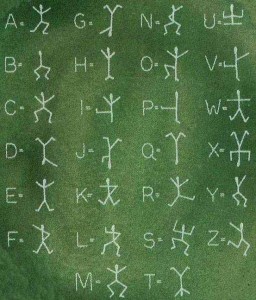
Here is another version (author not available)
Below you will find the alphabet of these dancing men. Men with a flag denote the last letter of a word.
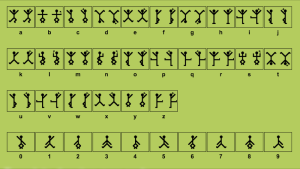
 Frank Mentzel, aka Merridew of Abominable Memory, is the current Gasogene of the Six Napoleons of Baltimore. His Appreciating Sherlock Holmes classes for the Community Colleges of Baltimore County, MD meet four times each during the spring and fall semesters, which would make it the second most active Sherlockian group in Maryland.
Frank Mentzel, aka Merridew of Abominable Memory, is the current Gasogene of the Six Napoleons of Baltimore. His Appreciating Sherlock Holmes classes for the Community Colleges of Baltimore County, MD meet four times each during the spring and fall semesters, which would make it the second most active Sherlockian group in Maryland.

I love this feature, I can’t wait for all 60 stories to be done.